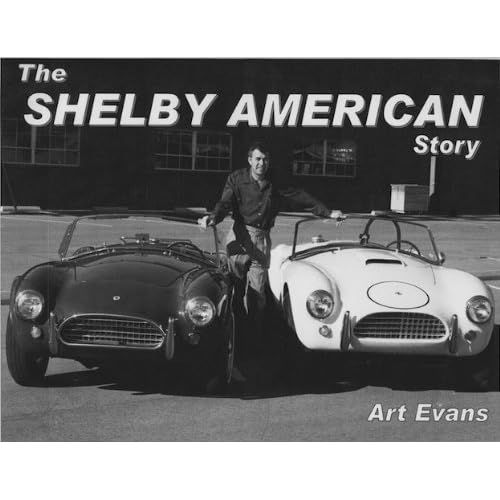The Shelby American Story by Art Evans
Published by Photo Data Research, Redondo Beach,CA
128 pages, hardbound, $39.95
Art Evans is the “grand old man” of sports car historians in the U.S. at least in the postwar era. He was there way back then, more than 60 years ago, as an amateur driver, and despite various careers in the military and academic circles , has never lost track of the early sports car drivers.
Hence he was well qualified to do this hardbound book.
It is his second on Shelby, the first covering Shelby as a race driver. He also previously did one on Ken Miles, one of the most famous Shelby drivers. This one goes into Shelby as a carmaker but also is a paean to the many drivers who drove for Shelby, some obscure, some internationally known.
The book is somewhat choppy in its organization, jumping from profiles of race drivers like Ken Miles and Bill Krause and then back to the cars they drove. For instance, the section called “Bill Krause” is followed by sections called “The First Race” and “The 1962 Bahamas” This writer would have preferred there be an ongoing narrative throughout and the drivers and or cars described in “break out” boxes so you can stop and read about them or just continue with the narrative.
Where some Shelby histories play down the Sunbeam Tiger, this author gives adequate credit to Shelby’s role in developing the car and also to Ken Miles’ lesser known role developing the same car. Oddly Mario Andretti gets a chapter when his role for Shelby was, as far as we know, only a couple of races. Lew Spencer is given credit as a mainstay of Shelby-American, and his dealership with Shelby is explained. Briefly, Shelby started it for him and Spencer to sell Cobras and Shelbys but they didn’t look at the fine print—they were forbidden to sell them new because they weren’t Ford dealers! But they could sell used cars…
Phil Remington is given proper credit as Shelby’s most skilled mechanic. I don’t think there’s mention of Phil’s pre-WWII role as a hot rodder but that was one of the reasons Shelby chose Los Angeles to build the Cobra—because it was the birthplace of hot-rodding. The brief Toyota episode in Shelby’s life is explored, showing the 2000GT cars that his team refined and raced but there’s no mention of Pete Brock’s oft-heard complaint that he had set up the deal to develop a race car out of the 2000GT and was about to sign a contract when Shelby swooped into Japan and made off with that plum assignment. Evans doesn’t want to get into politics, whereas sometimes that makes for entertaining reading.
Art did some good digging in the case of the vanished Shelby Indy 500 turbine car. He came up with pictures of the car in its Botany 500 (clothing manufacturer) livery and does allude to hanky panky with the air intake, which most historians feel is the reason it was pulled before the race, never to turn a wheel in combat.
The book has many fine photographic portraits of people. Even if Evans were not a writer, his portraits are remarkable into seeing into the subjects’ minds, “capturing their soul.”
The epilogue, like Evans earlier book on Shelby the driver, is all too brief. There isn’t any explanation, for instance, of why Shelby went to work for Iacocca at Chrysler. The picture of the Shelby Series I, the Olds-powered car, gives the details of the car in a caption but gives no clue that at the car was a failure in the marketplace.
Overall, I found this 128-page book less rewarding in terms of value-for-the-money than the Shelby-as-driver book by the same author and it’s a bit steep at $39.95. Still, nobody else could have done it--Evans must be respected in the auto racing community for the way so many people were forthcoming with information and pictures. We wish some of the more deluxe coffee table books could have his level of expertise displayed instead of thinking we will be satisfied with pretty color “glamour” pictures of restored cars.
One has to give credit to these independent historians, working on their own nickel (no cash advances for them) for coming up with pictures and info that take a lot of digging and a lot of contacts.

Shelby's Look awesome. I am from Ireland so we dont see or hear of them too often. I wish i had enough cash to purchase one even if it was just as an ornament.
ReplyDelete^^^
ReplyDeleteWhat is the running price for one of these vehicles? Or a range?
shelbies are so cool!
ReplyDeleteI only once saw one over here at a automobile show.
ReplyDeleteLooks great! Come check me out, alphabetalife.blogspot.com
ReplyDeleteHmm, I didn't know that. Thanks for the info.
ReplyDeleteYou know, it is refreshing to see what could be a decent coffee table book on Shelbys. They are a car that is not that known, especially with today's youth. I am a car nut, and I love older cars (and yes, the Camaros and Chevelles that everyone else loves too) but there is a level of respect to be had with the Shelby. I just wanted to add that Caroll's Shelby also won the World's Manufacturers' Championship in 1965. Pretty neat stuff.
ReplyDeletegreat post. following you
ReplyDeleteShelbys vary in price depending on what kind of action they have seen. Ones that have been in races can be up in the high hundred thousands to the millions. I just saw a used 500GT Super Snake selling for $80k as opposed to the entry level Mustangs in the $20k-30k range (new).
ReplyDeleteits a good story
ReplyDeleteLooks pretty sweet (:
ReplyDeleteIf I didn't hate reading so much (except charles bukowski) I'd check this out ;) hehe
ReplyDeleteThat looks pretty good.
ReplyDeleteThanks for the recommendation!
ReplyDelete